Chemical Risk Assessment Report: Benzo[a]pyrene in Biosolids
VerifiedAdded on 2022/09/22
|22
|3535
|21
Report
AI Summary
This report presents a chemical risk assessment of Benzo[a]pyrene (BaP), a contaminant found in biosolids, focusing on potential health risks in a residential setting near Sydney, Australia. The assessment, conducted for a CVEN9892 assignment, evaluates exposure pathways including dermal contact, inhalation, and ingestion, considering a 2-year-old child and two adults. The study determines BaP concentrations, hazard identification, dose-response assessment, and risk characterization. The report calculates both carcinogenic and non-carcinogenic risks, utilizing standard formulae and exposure parameters. It also includes uncertainty analysis and concludes that the calculated cumulative risk falls within acceptable ranges, recommending further investigation. The report addresses the aim to assess the chemical risks of BaP and its objectives to determine the concentration of BaP in soil conditioning fertilizer and establish the routes through which BaP is found in biosolids. The conceptual site model, exposure pathways, and exposed population scenarios are detailed, along with the risk assessment methodology and results.

CHEMICAL ENGINEERING
By Name
Course
Instructor
Institution
Location
Date
By Name
Course
Instructor
Institution
Location
Date
Paraphrase This Document
Need a fresh take? Get an instant paraphrase of this document with our AI Paraphraser
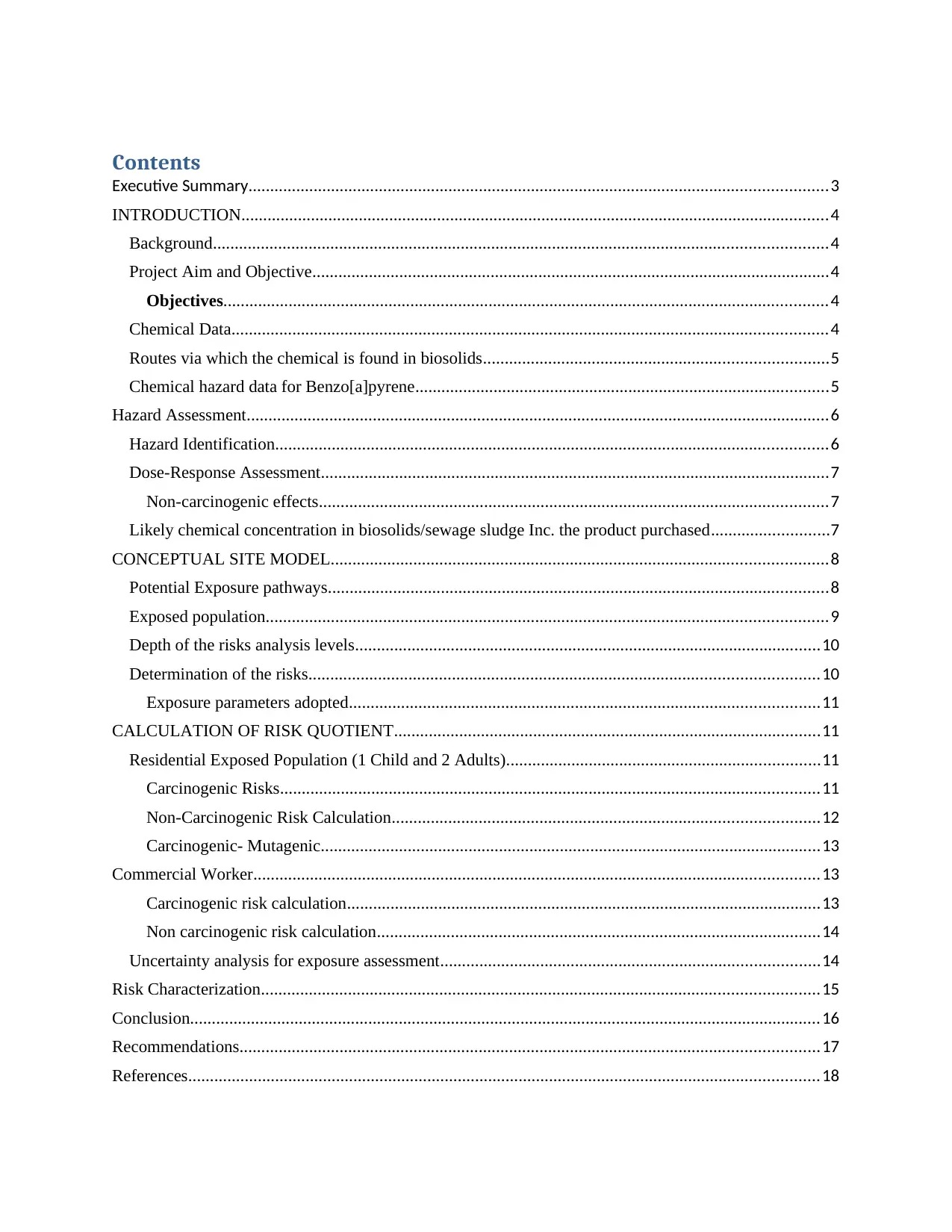
Contents
Executive Summary.....................................................................................................................................3
INTRODUCTION.......................................................................................................................................4
Background.............................................................................................................................................4
Project Aim and Objective.......................................................................................................................4
Objectives...........................................................................................................................................4
Chemical Data.........................................................................................................................................4
Routes via which the chemical is found in biosolids...............................................................................5
Chemical hazard data for Benzo[a]pyrene...............................................................................................5
Hazard Assessment......................................................................................................................................6
Hazard Identification...............................................................................................................................6
Dose-Response Assessment.....................................................................................................................7
Non-carcinogenic effects.....................................................................................................................7
Likely chemical concentration in biosolids/sewage sludge Inc. the product purchased...........................7
CONCEPTUAL SITE MODEL..................................................................................................................8
Potential Exposure pathways...................................................................................................................8
Exposed population.................................................................................................................................9
Depth of the risks analysis levels...........................................................................................................10
Determination of the risks.....................................................................................................................10
Exposure parameters adopted............................................................................................................11
CALCULATION OF RISK QUOTIENT..................................................................................................11
Residential Exposed Population (1 Child and 2 Adults)........................................................................11
Carcinogenic Risks............................................................................................................................11
Non-Carcinogenic Risk Calculation..................................................................................................12
Carcinogenic- Mutagenic...................................................................................................................13
Commercial Worker..................................................................................................................................13
Carcinogenic risk calculation.............................................................................................................13
Non carcinogenic risk calculation......................................................................................................14
Uncertainty analysis for exposure assessment.......................................................................................14
Risk Characterization................................................................................................................................15
Conclusion.................................................................................................................................................16
Recommendations.....................................................................................................................................17
References.................................................................................................................................................18
Executive Summary.....................................................................................................................................3
INTRODUCTION.......................................................................................................................................4
Background.............................................................................................................................................4
Project Aim and Objective.......................................................................................................................4
Objectives...........................................................................................................................................4
Chemical Data.........................................................................................................................................4
Routes via which the chemical is found in biosolids...............................................................................5
Chemical hazard data for Benzo[a]pyrene...............................................................................................5
Hazard Assessment......................................................................................................................................6
Hazard Identification...............................................................................................................................6
Dose-Response Assessment.....................................................................................................................7
Non-carcinogenic effects.....................................................................................................................7
Likely chemical concentration in biosolids/sewage sludge Inc. the product purchased...........................7
CONCEPTUAL SITE MODEL..................................................................................................................8
Potential Exposure pathways...................................................................................................................8
Exposed population.................................................................................................................................9
Depth of the risks analysis levels...........................................................................................................10
Determination of the risks.....................................................................................................................10
Exposure parameters adopted............................................................................................................11
CALCULATION OF RISK QUOTIENT..................................................................................................11
Residential Exposed Population (1 Child and 2 Adults)........................................................................11
Carcinogenic Risks............................................................................................................................11
Non-Carcinogenic Risk Calculation..................................................................................................12
Carcinogenic- Mutagenic...................................................................................................................13
Commercial Worker..................................................................................................................................13
Carcinogenic risk calculation.............................................................................................................13
Non carcinogenic risk calculation......................................................................................................14
Uncertainty analysis for exposure assessment.......................................................................................14
Risk Characterization................................................................................................................................15
Conclusion.................................................................................................................................................16
Recommendations.....................................................................................................................................17
References.................................................................................................................................................18
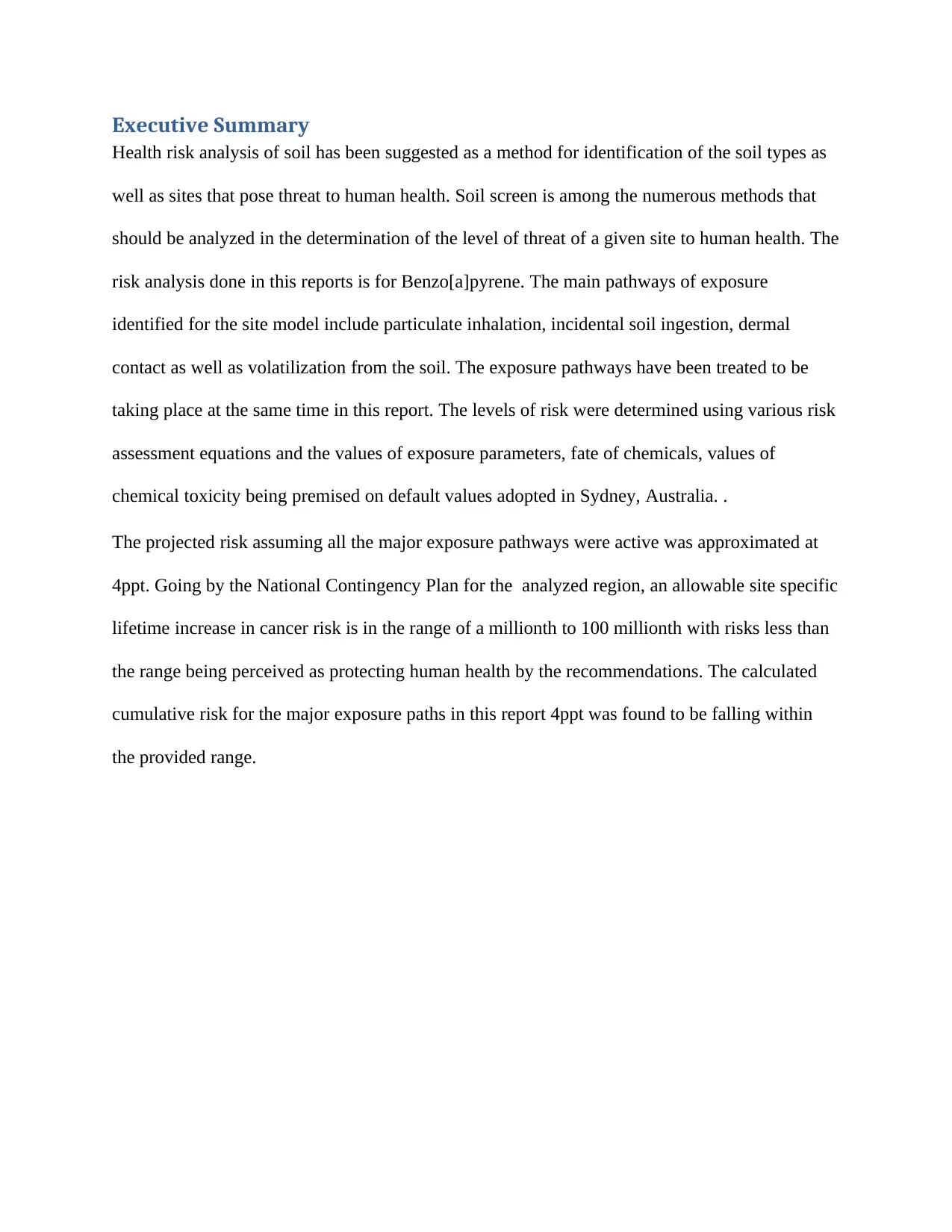
Executive Summary
Health risk analysis of soil has been suggested as a method for identification of the soil types as
well as sites that pose threat to human health. Soil screen is among the numerous methods that
should be analyzed in the determination of the level of threat of a given site to human health. The
risk analysis done in this reports is for Benzo[a]pyrene. The main pathways of exposure
identified for the site model include particulate inhalation, incidental soil ingestion, dermal
contact as well as volatilization from the soil. The exposure pathways have been treated to be
taking place at the same time in this report. The levels of risk were determined using various risk
assessment equations and the values of exposure parameters, fate of chemicals, values of
chemical toxicity being premised on default values adopted in Sydney, Australia. .
The projected risk assuming all the major exposure pathways were active was approximated at
4ppt. Going by the National Contingency Plan for the analyzed region, an allowable site specific
lifetime increase in cancer risk is in the range of a millionth to 100 millionth with risks less than
the range being perceived as protecting human health by the recommendations. The calculated
cumulative risk for the major exposure paths in this report 4ppt was found to be falling within
the provided range.
Health risk analysis of soil has been suggested as a method for identification of the soil types as
well as sites that pose threat to human health. Soil screen is among the numerous methods that
should be analyzed in the determination of the level of threat of a given site to human health. The
risk analysis done in this reports is for Benzo[a]pyrene. The main pathways of exposure
identified for the site model include particulate inhalation, incidental soil ingestion, dermal
contact as well as volatilization from the soil. The exposure pathways have been treated to be
taking place at the same time in this report. The levels of risk were determined using various risk
assessment equations and the values of exposure parameters, fate of chemicals, values of
chemical toxicity being premised on default values adopted in Sydney, Australia. .
The projected risk assuming all the major exposure pathways were active was approximated at
4ppt. Going by the National Contingency Plan for the analyzed region, an allowable site specific
lifetime increase in cancer risk is in the range of a millionth to 100 millionth with risks less than
the range being perceived as protecting human health by the recommendations. The calculated
cumulative risk for the major exposure paths in this report 4ppt was found to be falling within
the provided range.
⊘ This is a preview!⊘
Do you want full access?
Subscribe today to unlock all pages.

Trusted by 1+ million students worldwide
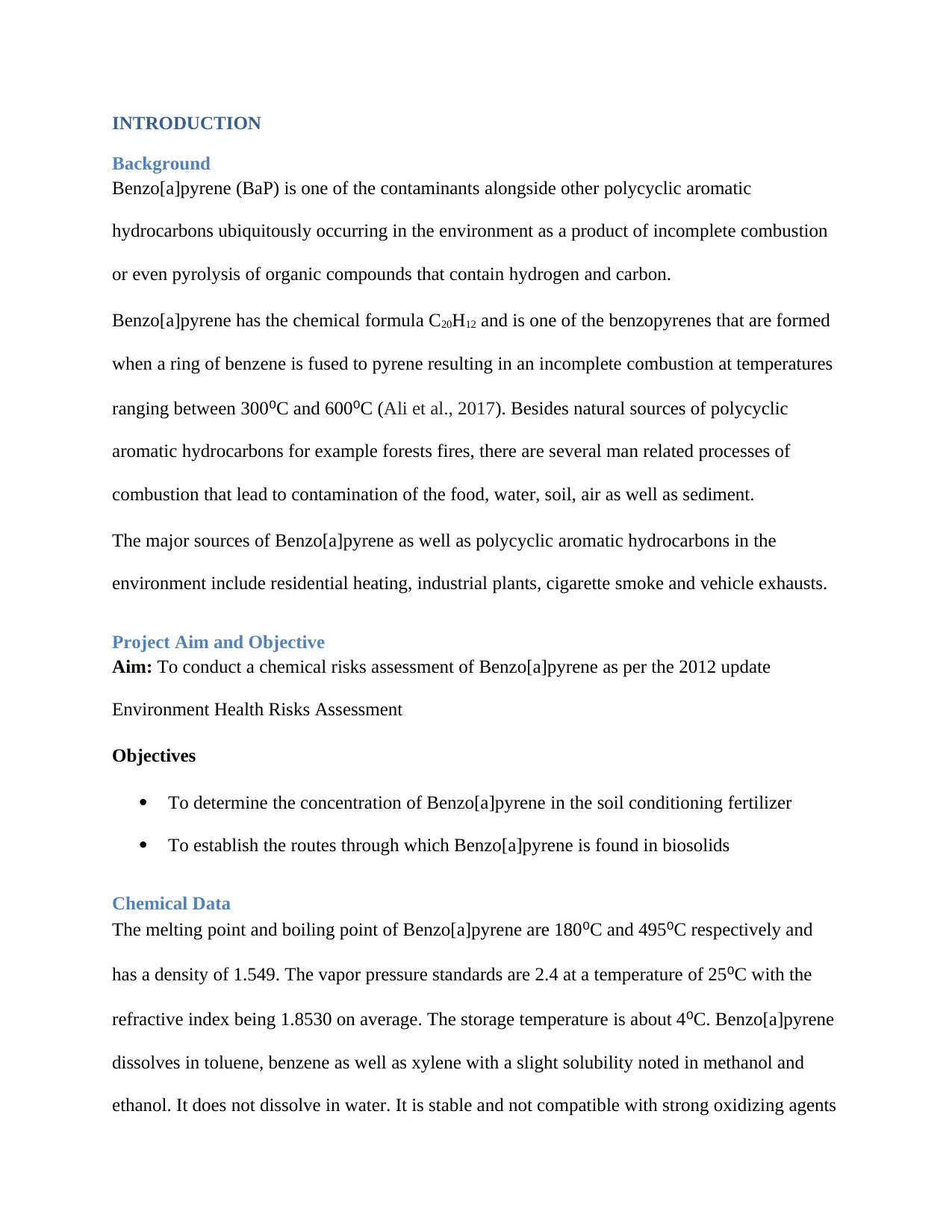
INTRODUCTION
Background
Benzo[a]pyrene (BaP) is one of the contaminants alongside other polycyclic aromatic
hydrocarbons ubiquitously occurring in the environment as a product of incomplete combustion
or even pyrolysis of organic compounds that contain hydrogen and carbon.
Benzo[a]pyrene has the chemical formula C20H12 and is one of the benzopyrenes that are formed
when a ring of benzene is fused to pyrene resulting in an incomplete combustion at temperatures
ranging between 300⁰C and 600⁰C (Ali et al., 2017). Besides natural sources of polycyclic
aromatic hydrocarbons for example forests fires, there are several man related processes of
combustion that lead to contamination of the food, water, soil, air as well as sediment.
The major sources of Benzo[a]pyrene as well as polycyclic aromatic hydrocarbons in the
environment include residential heating, industrial plants, cigarette smoke and vehicle exhausts.
Project Aim and Objective
Aim: To conduct a chemical risks assessment of Benzo[a]pyrene as per the 2012 update
Environment Health Risks Assessment
Objectives
To determine the concentration of Benzo[a]pyrene in the soil conditioning fertilizer
To establish the routes through which Benzo[a]pyrene is found in biosolids
Chemical Data
The melting point and boiling point of Benzo[a]pyrene are 180⁰C and 495⁰C respectively and
has a density of 1.549. The vapor pressure standards are 2.4 at a temperature of 25⁰C with the
refractive index being 1.8530 on average. The storage temperature is about 4⁰C. Benzo[a]pyrene
dissolves in toluene, benzene as well as xylene with a slight solubility noted in methanol and
ethanol. It does not dissolve in water. It is stable and not compatible with strong oxidizing agents
Background
Benzo[a]pyrene (BaP) is one of the contaminants alongside other polycyclic aromatic
hydrocarbons ubiquitously occurring in the environment as a product of incomplete combustion
or even pyrolysis of organic compounds that contain hydrogen and carbon.
Benzo[a]pyrene has the chemical formula C20H12 and is one of the benzopyrenes that are formed
when a ring of benzene is fused to pyrene resulting in an incomplete combustion at temperatures
ranging between 300⁰C and 600⁰C (Ali et al., 2017). Besides natural sources of polycyclic
aromatic hydrocarbons for example forests fires, there are several man related processes of
combustion that lead to contamination of the food, water, soil, air as well as sediment.
The major sources of Benzo[a]pyrene as well as polycyclic aromatic hydrocarbons in the
environment include residential heating, industrial plants, cigarette smoke and vehicle exhausts.
Project Aim and Objective
Aim: To conduct a chemical risks assessment of Benzo[a]pyrene as per the 2012 update
Environment Health Risks Assessment
Objectives
To determine the concentration of Benzo[a]pyrene in the soil conditioning fertilizer
To establish the routes through which Benzo[a]pyrene is found in biosolids
Chemical Data
The melting point and boiling point of Benzo[a]pyrene are 180⁰C and 495⁰C respectively and
has a density of 1.549. The vapor pressure standards are 2.4 at a temperature of 25⁰C with the
refractive index being 1.8530 on average. The storage temperature is about 4⁰C. Benzo[a]pyrene
dissolves in toluene, benzene as well as xylene with a slight solubility noted in methanol and
ethanol. It does not dissolve in water. It is stable and not compatible with strong oxidizing agents
Paraphrase This Document
Need a fresh take? Get an instant paraphrase of this document with our AI Paraphraser
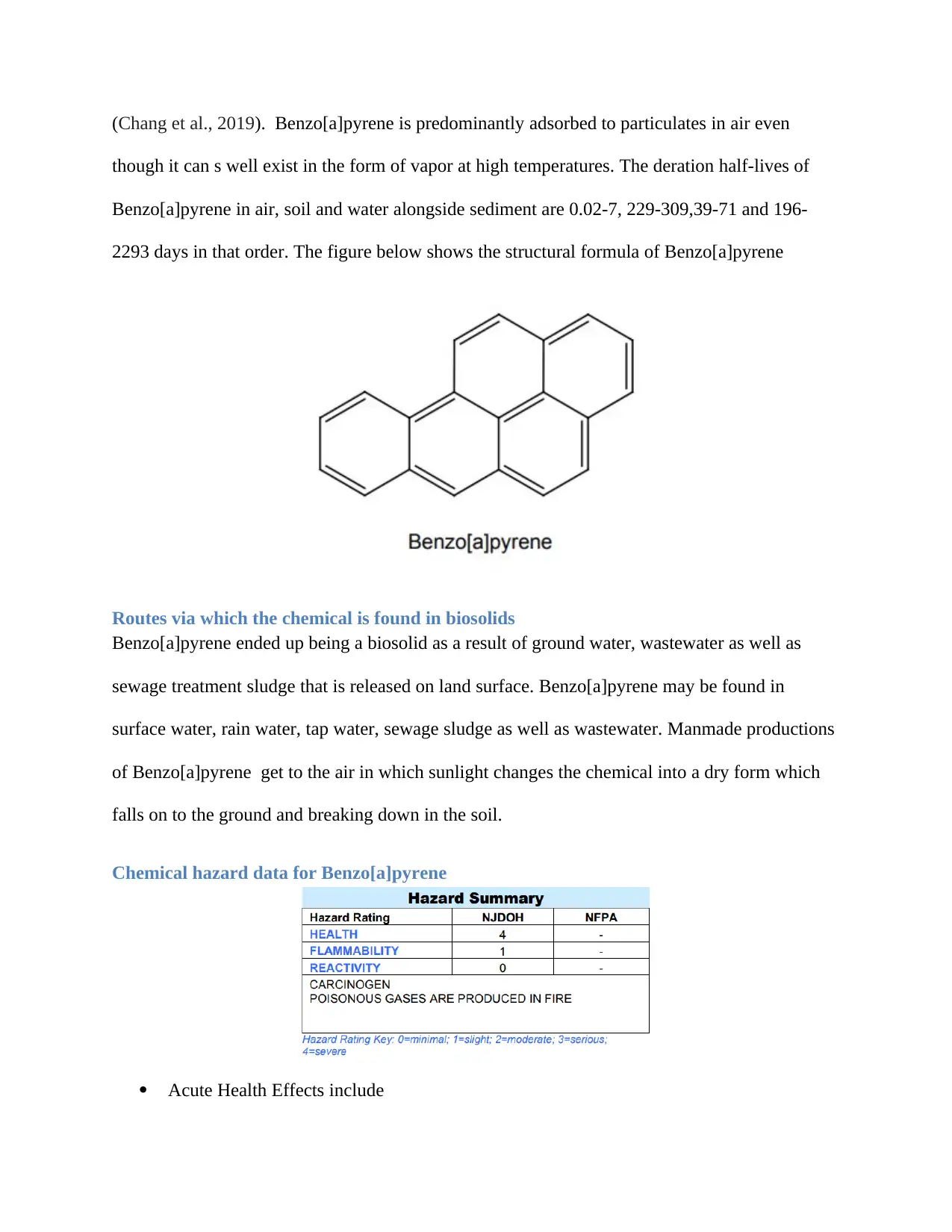
(Chang et al., 2019). Benzo[a]pyrene is predominantly adsorbed to particulates in air even
though it can s well exist in the form of vapor at high temperatures. The deration half-lives of
Benzo[a]pyrene in air, soil and water alongside sediment are 0.02-7, 229-309,39-71 and 196-
2293 days in that order. The figure below shows the structural formula of Benzo[a]pyrene
Routes via which the chemical is found in biosolids
Benzo[a]pyrene ended up being a biosolid as a result of ground water, wastewater as well as
sewage treatment sludge that is released on land surface. Benzo[a]pyrene may be found in
surface water, rain water, tap water, sewage sludge as well as wastewater. Manmade productions
of Benzo[a]pyrene get to the air in which sunlight changes the chemical into a dry form which
falls on to the ground and breaking down in the soil.
Chemical hazard data for Benzo[a]pyrene
Acute Health Effects include
though it can s well exist in the form of vapor at high temperatures. The deration half-lives of
Benzo[a]pyrene in air, soil and water alongside sediment are 0.02-7, 229-309,39-71 and 196-
2293 days in that order. The figure below shows the structural formula of Benzo[a]pyrene
Routes via which the chemical is found in biosolids
Benzo[a]pyrene ended up being a biosolid as a result of ground water, wastewater as well as
sewage treatment sludge that is released on land surface. Benzo[a]pyrene may be found in
surface water, rain water, tap water, sewage sludge as well as wastewater. Manmade productions
of Benzo[a]pyrene get to the air in which sunlight changes the chemical into a dry form which
falls on to the ground and breaking down in the soil.
Chemical hazard data for Benzo[a]pyrene
Acute Health Effects include
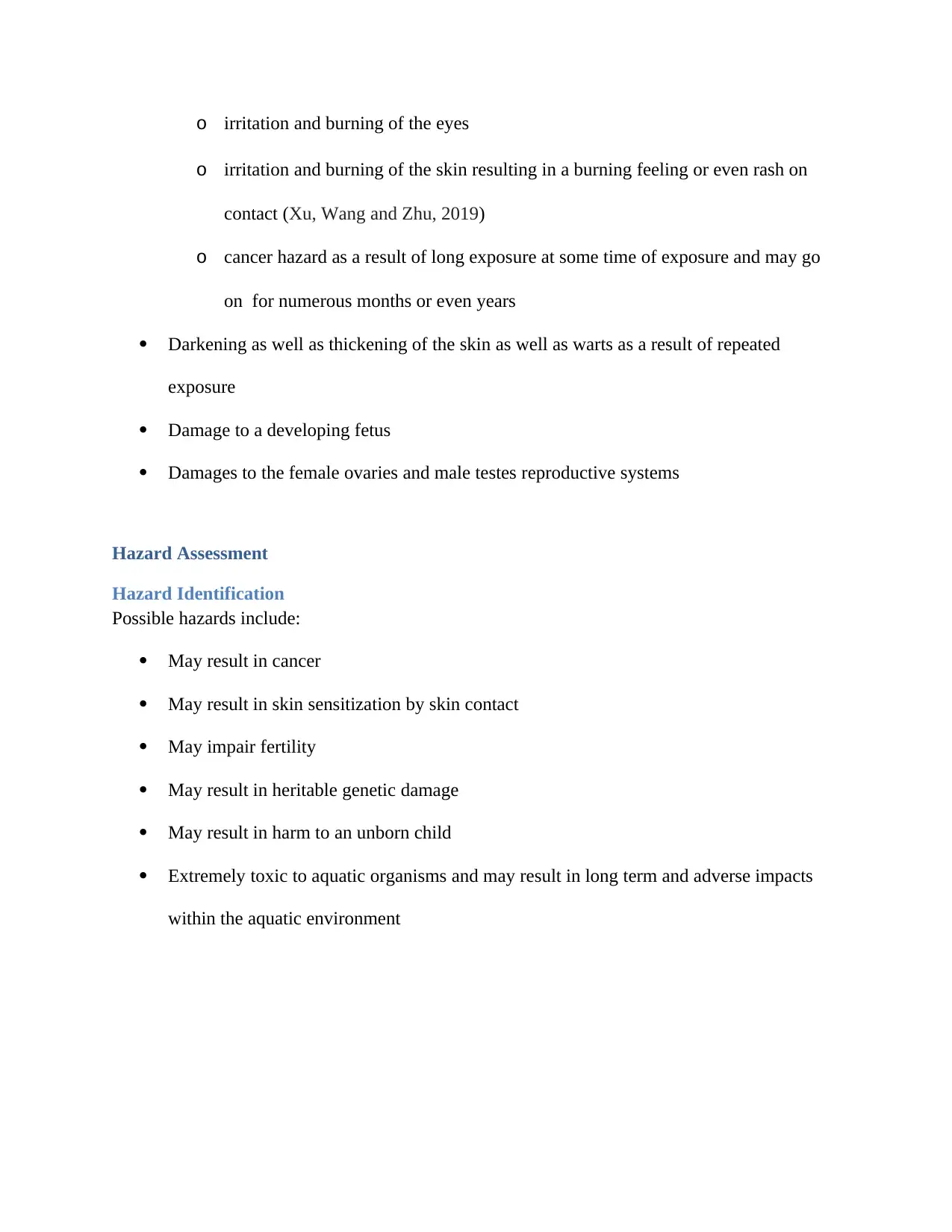
o irritation and burning of the eyes
o irritation and burning of the skin resulting in a burning feeling or even rash on
contact (Xu, Wang and Zhu, 2019)
o cancer hazard as a result of long exposure at some time of exposure and may go
on for numerous months or even years
Darkening as well as thickening of the skin as well as warts as a result of repeated
exposure
Damage to a developing fetus
Damages to the female ovaries and male testes reproductive systems
Hazard Assessment
Hazard Identification
Possible hazards include:
May result in cancer
May result in skin sensitization by skin contact
May impair fertility
May result in heritable genetic damage
May result in harm to an unborn child
Extremely toxic to aquatic organisms and may result in long term and adverse impacts
within the aquatic environment
o irritation and burning of the skin resulting in a burning feeling or even rash on
contact (Xu, Wang and Zhu, 2019)
o cancer hazard as a result of long exposure at some time of exposure and may go
on for numerous months or even years
Darkening as well as thickening of the skin as well as warts as a result of repeated
exposure
Damage to a developing fetus
Damages to the female ovaries and male testes reproductive systems
Hazard Assessment
Hazard Identification
Possible hazards include:
May result in cancer
May result in skin sensitization by skin contact
May impair fertility
May result in heritable genetic damage
May result in harm to an unborn child
Extremely toxic to aquatic organisms and may result in long term and adverse impacts
within the aquatic environment
⊘ This is a preview!⊘
Do you want full access?
Subscribe today to unlock all pages.

Trusted by 1+ million students worldwide
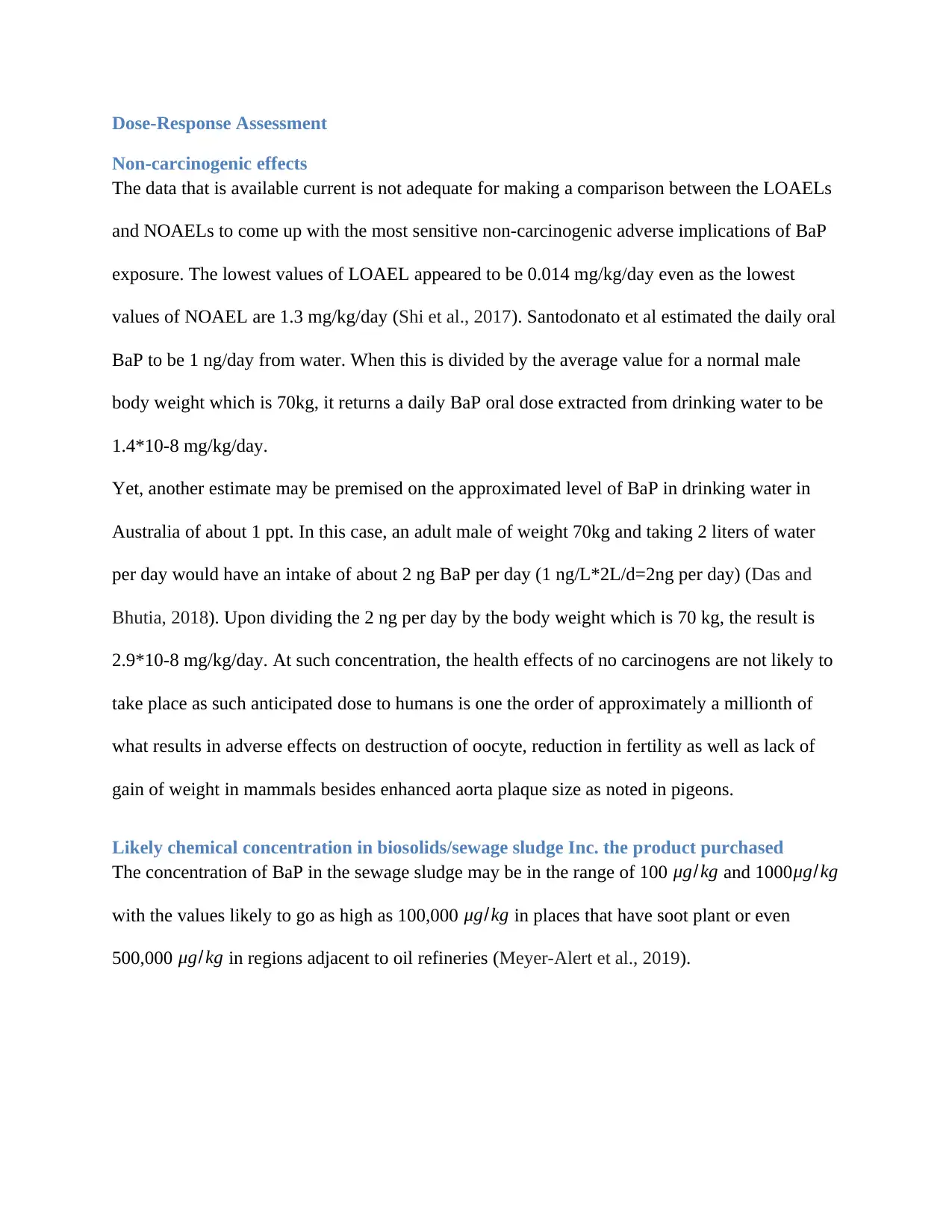
Dose-Response Assessment
Non-carcinogenic effects
The data that is available current is not adequate for making a comparison between the LOAELs
and NOAELs to come up with the most sensitive non-carcinogenic adverse implications of BaP
exposure. The lowest values of LOAEL appeared to be 0.014 mg/kg/day even as the lowest
values of NOAEL are 1.3 mg/kg/day (Shi et al., 2017). Santodonato et al estimated the daily oral
BaP to be 1 ng/day from water. When this is divided by the average value for a normal male
body weight which is 70kg, it returns a daily BaP oral dose extracted from drinking water to be
1.4*10-8 mg/kg/day.
Yet, another estimate may be premised on the approximated level of BaP in drinking water in
Australia of about 1 ppt. In this case, an adult male of weight 70kg and taking 2 liters of water
per day would have an intake of about 2 ng BaP per day (1 ng/L*2L/d=2ng per day) (Das and
Bhutia, 2018). Upon dividing the 2 ng per day by the body weight which is 70 kg, the result is
2.9*10-8 mg/kg/day. At such concentration, the health effects of no carcinogens are not likely to
take place as such anticipated dose to humans is one the order of approximately a millionth of
what results in adverse effects on destruction of oocyte, reduction in fertility as well as lack of
gain of weight in mammals besides enhanced aorta plaque size as noted in pigeons.
Likely chemical concentration in biosolids/sewage sludge Inc. the product purchased
The concentration of BaP in the sewage sludge may be in the range of 100 μg/ kg and 1000 μg/kg
with the values likely to go as high as 100,000 μg/kg in places that have soot plant or even
500,000 μg/ kg in regions adjacent to oil refineries (Meyer-Alert et al., 2019).
Non-carcinogenic effects
The data that is available current is not adequate for making a comparison between the LOAELs
and NOAELs to come up with the most sensitive non-carcinogenic adverse implications of BaP
exposure. The lowest values of LOAEL appeared to be 0.014 mg/kg/day even as the lowest
values of NOAEL are 1.3 mg/kg/day (Shi et al., 2017). Santodonato et al estimated the daily oral
BaP to be 1 ng/day from water. When this is divided by the average value for a normal male
body weight which is 70kg, it returns a daily BaP oral dose extracted from drinking water to be
1.4*10-8 mg/kg/day.
Yet, another estimate may be premised on the approximated level of BaP in drinking water in
Australia of about 1 ppt. In this case, an adult male of weight 70kg and taking 2 liters of water
per day would have an intake of about 2 ng BaP per day (1 ng/L*2L/d=2ng per day) (Das and
Bhutia, 2018). Upon dividing the 2 ng per day by the body weight which is 70 kg, the result is
2.9*10-8 mg/kg/day. At such concentration, the health effects of no carcinogens are not likely to
take place as such anticipated dose to humans is one the order of approximately a millionth of
what results in adverse effects on destruction of oocyte, reduction in fertility as well as lack of
gain of weight in mammals besides enhanced aorta plaque size as noted in pigeons.
Likely chemical concentration in biosolids/sewage sludge Inc. the product purchased
The concentration of BaP in the sewage sludge may be in the range of 100 μg/ kg and 1000 μg/kg
with the values likely to go as high as 100,000 μg/kg in places that have soot plant or even
500,000 μg/ kg in regions adjacent to oil refineries (Meyer-Alert et al., 2019).
Paraphrase This Document
Need a fresh take? Get an instant paraphrase of this document with our AI Paraphraser
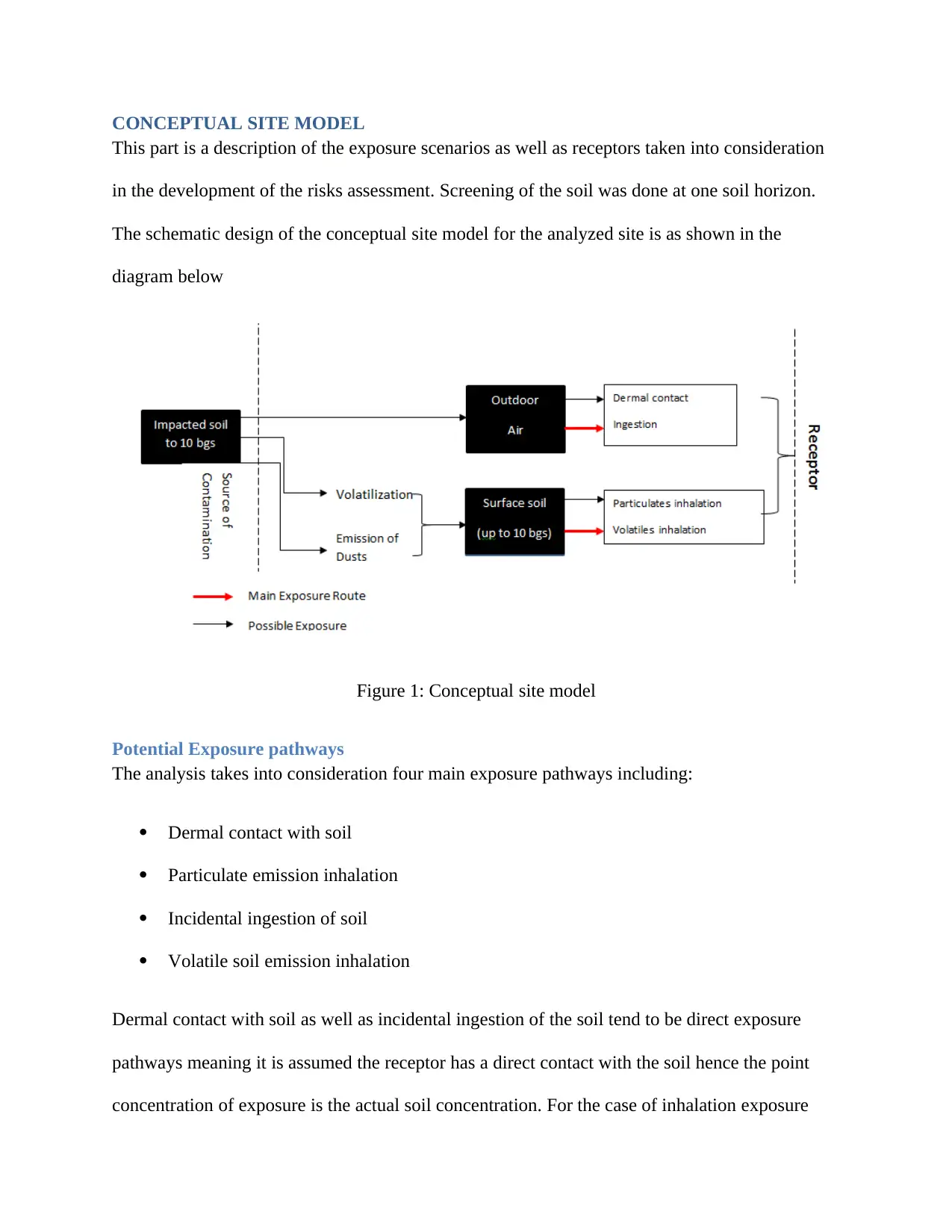
CONCEPTUAL SITE MODEL
This part is a description of the exposure scenarios as well as receptors taken into consideration
in the development of the risks assessment. Screening of the soil was done at one soil horizon.
The schematic design of the conceptual site model for the analyzed site is as shown in the
diagram below
Figure 1: Conceptual site model
Potential Exposure pathways
The analysis takes into consideration four main exposure pathways including:
Dermal contact with soil
Particulate emission inhalation
Incidental ingestion of soil
Volatile soil emission inhalation
Dermal contact with soil as well as incidental ingestion of the soil tend to be direct exposure
pathways meaning it is assumed the receptor has a direct contact with the soil hence the point
concentration of exposure is the actual soil concentration. For the case of inhalation exposure
This part is a description of the exposure scenarios as well as receptors taken into consideration
in the development of the risks assessment. Screening of the soil was done at one soil horizon.
The schematic design of the conceptual site model for the analyzed site is as shown in the
diagram below
Figure 1: Conceptual site model
Potential Exposure pathways
The analysis takes into consideration four main exposure pathways including:
Dermal contact with soil
Particulate emission inhalation
Incidental ingestion of soil
Volatile soil emission inhalation
Dermal contact with soil as well as incidental ingestion of the soil tend to be direct exposure
pathways meaning it is assumed the receptor has a direct contact with the soil hence the point
concentration of exposure is the actual soil concentration. For the case of inhalation exposure
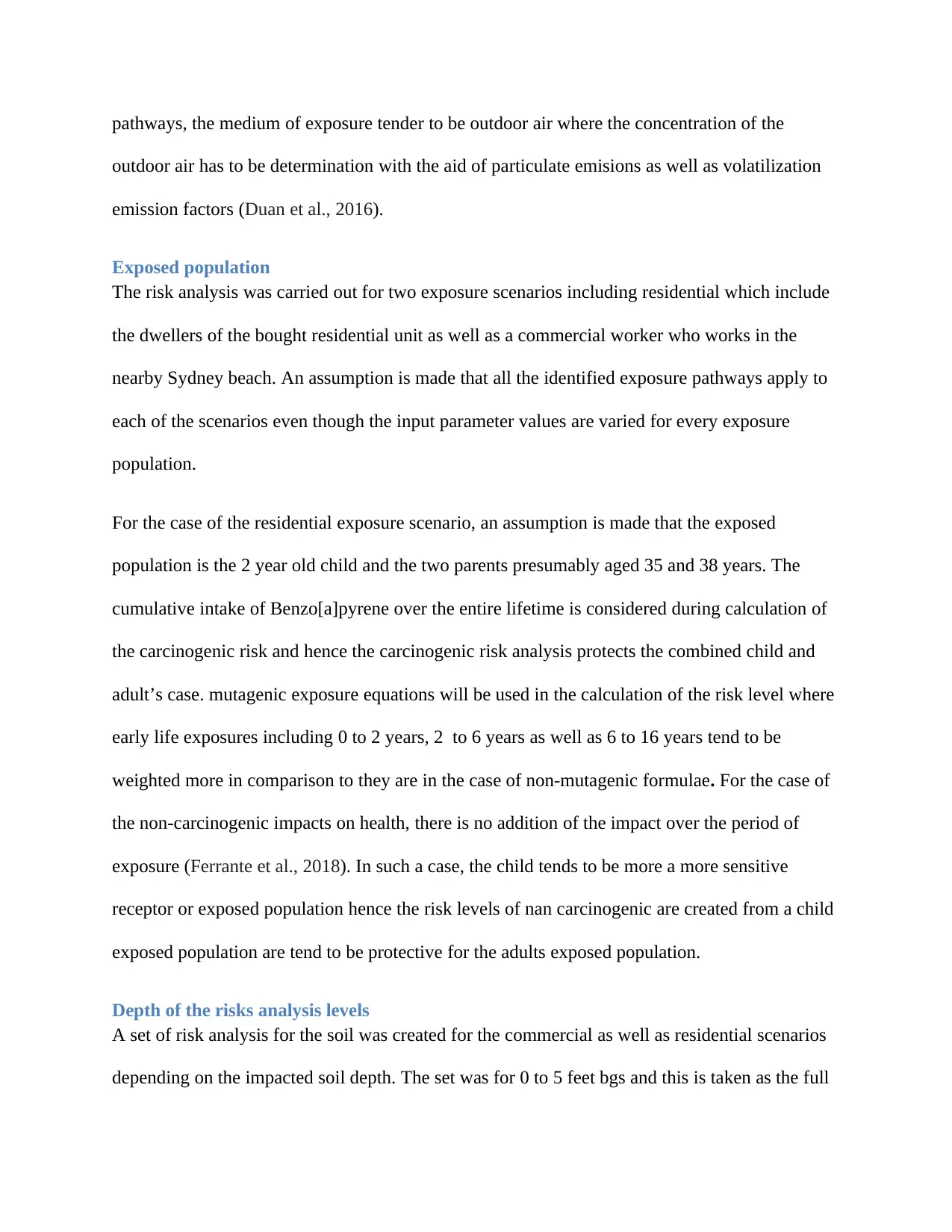
pathways, the medium of exposure tender to be outdoor air where the concentration of the
outdoor air has to be determination with the aid of particulate emisions as well as volatilization
emission factors (Duan et al., 2016).
Exposed population
The risk analysis was carried out for two exposure scenarios including residential which include
the dwellers of the bought residential unit as well as a commercial worker who works in the
nearby Sydney beach. An assumption is made that all the identified exposure pathways apply to
each of the scenarios even though the input parameter values are varied for every exposure
population.
For the case of the residential exposure scenario, an assumption is made that the exposed
population is the 2 year old child and the two parents presumably aged 35 and 38 years. The
cumulative intake of Benzo[a]pyrene over the entire lifetime is considered during calculation of
the carcinogenic risk and hence the carcinogenic risk analysis protects the combined child and
adult’s case. mutagenic exposure equations will be used in the calculation of the risk level where
early life exposures including 0 to 2 years, 2 to 6 years as well as 6 to 16 years tend to be
weighted more in comparison to they are in the case of non-mutagenic formulae. For the case of
the non-carcinogenic impacts on health, there is no addition of the impact over the period of
exposure (Ferrante et al., 2018). In such a case, the child tends to be more a more sensitive
receptor or exposed population hence the risk levels of nan carcinogenic are created from a child
exposed population are tend to be protective for the adults exposed population.
Depth of the risks analysis levels
A set of risk analysis for the soil was created for the commercial as well as residential scenarios
depending on the impacted soil depth. The set was for 0 to 5 feet bgs and this is taken as the full
outdoor air has to be determination with the aid of particulate emisions as well as volatilization
emission factors (Duan et al., 2016).
Exposed population
The risk analysis was carried out for two exposure scenarios including residential which include
the dwellers of the bought residential unit as well as a commercial worker who works in the
nearby Sydney beach. An assumption is made that all the identified exposure pathways apply to
each of the scenarios even though the input parameter values are varied for every exposure
population.
For the case of the residential exposure scenario, an assumption is made that the exposed
population is the 2 year old child and the two parents presumably aged 35 and 38 years. The
cumulative intake of Benzo[a]pyrene over the entire lifetime is considered during calculation of
the carcinogenic risk and hence the carcinogenic risk analysis protects the combined child and
adult’s case. mutagenic exposure equations will be used in the calculation of the risk level where
early life exposures including 0 to 2 years, 2 to 6 years as well as 6 to 16 years tend to be
weighted more in comparison to they are in the case of non-mutagenic formulae. For the case of
the non-carcinogenic impacts on health, there is no addition of the impact over the period of
exposure (Ferrante et al., 2018). In such a case, the child tends to be more a more sensitive
receptor or exposed population hence the risk levels of nan carcinogenic are created from a child
exposed population are tend to be protective for the adults exposed population.
Depth of the risks analysis levels
A set of risk analysis for the soil was created for the commercial as well as residential scenarios
depending on the impacted soil depth. The set was for 0 to 5 feet bgs and this is taken as the full
⊘ This is a preview!⊘
Do you want full access?
Subscribe today to unlock all pages.

Trusted by 1+ million students worldwide
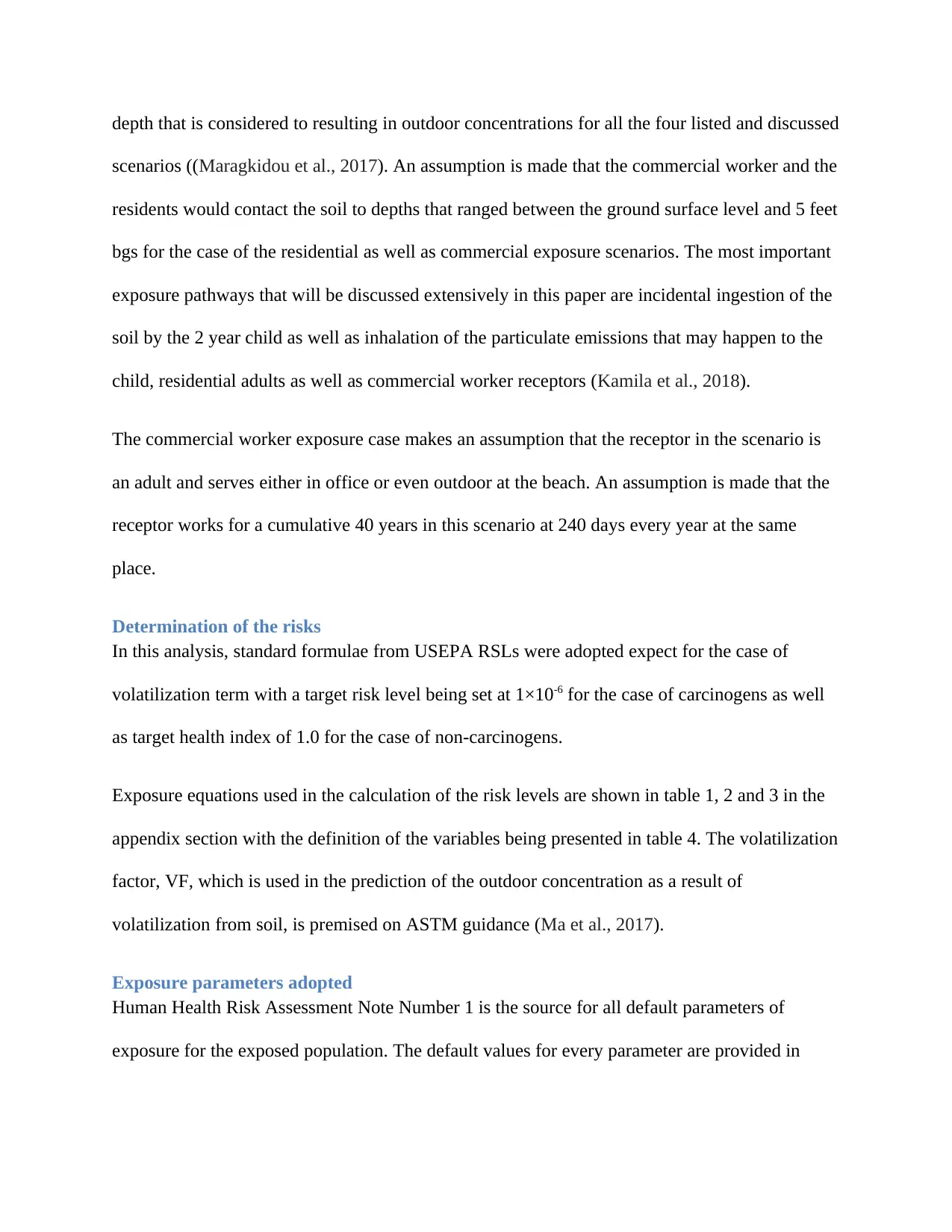
depth that is considered to resulting in outdoor concentrations for all the four listed and discussed
scenarios ((Maragkidou et al., 2017). An assumption is made that the commercial worker and the
residents would contact the soil to depths that ranged between the ground surface level and 5 feet
bgs for the case of the residential as well as commercial exposure scenarios. The most important
exposure pathways that will be discussed extensively in this paper are incidental ingestion of the
soil by the 2 year child as well as inhalation of the particulate emissions that may happen to the
child, residential adults as well as commercial worker receptors (Kamila et al., 2018).
The commercial worker exposure case makes an assumption that the receptor in the scenario is
an adult and serves either in office or even outdoor at the beach. An assumption is made that the
receptor works for a cumulative 40 years in this scenario at 240 days every year at the same
place.
Determination of the risks
In this analysis, standard formulae from USEPA RSLs were adopted expect for the case of
volatilization term with a target risk level being set at 1×10-6 for the case of carcinogens as well
as target health index of 1.0 for the case of non-carcinogens.
Exposure equations used in the calculation of the risk levels are shown in table 1, 2 and 3 in the
appendix section with the definition of the variables being presented in table 4. The volatilization
factor, VF, which is used in the prediction of the outdoor concentration as a result of
volatilization from soil, is premised on ASTM guidance (Ma et al., 2017).
Exposure parameters adopted
Human Health Risk Assessment Note Number 1 is the source for all default parameters of
exposure for the exposed population. The default values for every parameter are provided in
scenarios ((Maragkidou et al., 2017). An assumption is made that the commercial worker and the
residents would contact the soil to depths that ranged between the ground surface level and 5 feet
bgs for the case of the residential as well as commercial exposure scenarios. The most important
exposure pathways that will be discussed extensively in this paper are incidental ingestion of the
soil by the 2 year child as well as inhalation of the particulate emissions that may happen to the
child, residential adults as well as commercial worker receptors (Kamila et al., 2018).
The commercial worker exposure case makes an assumption that the receptor in the scenario is
an adult and serves either in office or even outdoor at the beach. An assumption is made that the
receptor works for a cumulative 40 years in this scenario at 240 days every year at the same
place.
Determination of the risks
In this analysis, standard formulae from USEPA RSLs were adopted expect for the case of
volatilization term with a target risk level being set at 1×10-6 for the case of carcinogens as well
as target health index of 1.0 for the case of non-carcinogens.
Exposure equations used in the calculation of the risk levels are shown in table 1, 2 and 3 in the
appendix section with the definition of the variables being presented in table 4. The volatilization
factor, VF, which is used in the prediction of the outdoor concentration as a result of
volatilization from soil, is premised on ASTM guidance (Ma et al., 2017).
Exposure parameters adopted
Human Health Risk Assessment Note Number 1 is the source for all default parameters of
exposure for the exposed population. The default values for every parameter are provided in
Paraphrase This Document
Need a fresh take? Get an instant paraphrase of this document with our AI Paraphraser
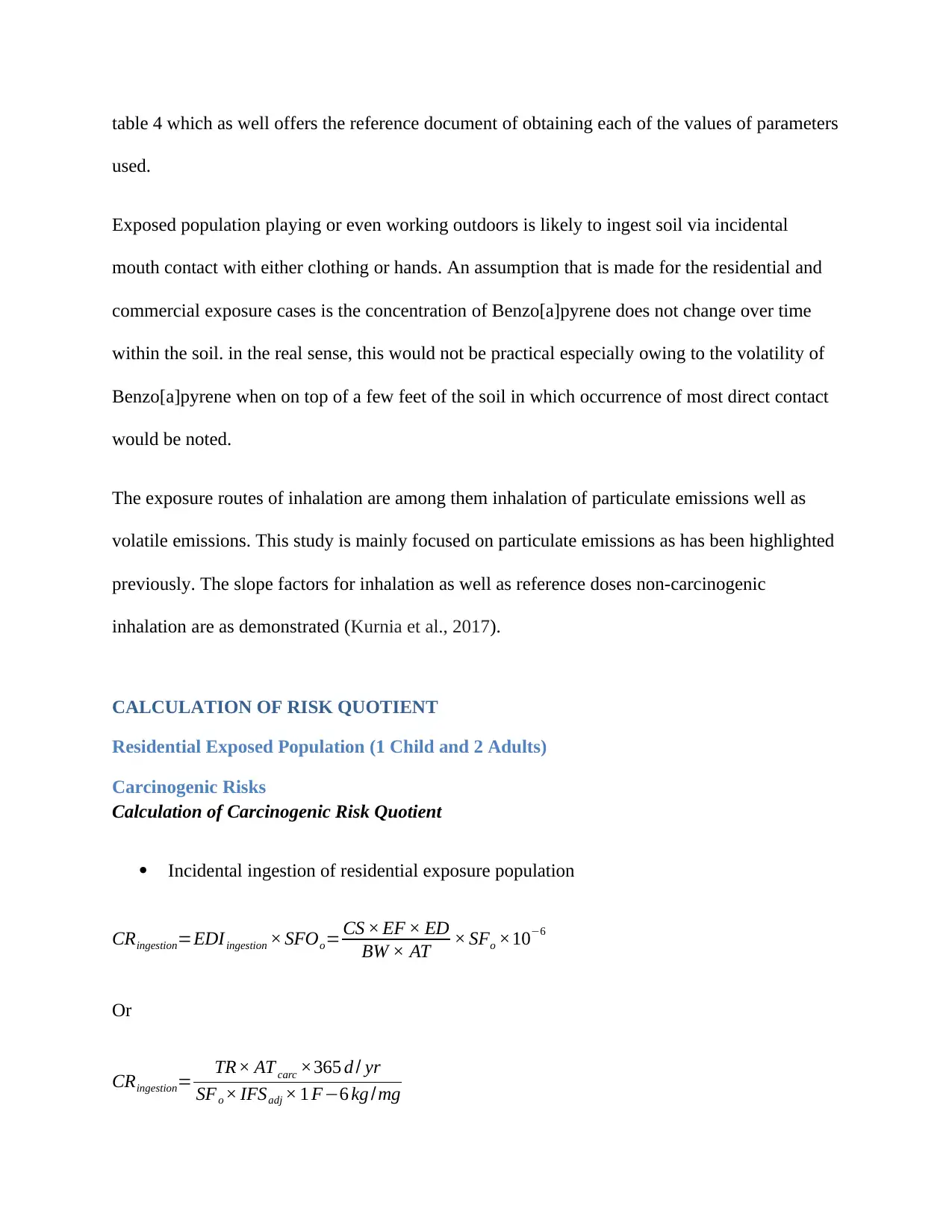
table 4 which as well offers the reference document of obtaining each of the values of parameters
used.
Exposed population playing or even working outdoors is likely to ingest soil via incidental
mouth contact with either clothing or hands. An assumption that is made for the residential and
commercial exposure cases is the concentration of Benzo[a]pyrene does not change over time
within the soil. in the real sense, this would not be practical especially owing to the volatility of
Benzo[a]pyrene when on top of a few feet of the soil in which occurrence of most direct contact
would be noted.
The exposure routes of inhalation are among them inhalation of particulate emissions well as
volatile emissions. This study is mainly focused on particulate emissions as has been highlighted
previously. The slope factors for inhalation as well as reference doses non-carcinogenic
inhalation are as demonstrated (Kurnia et al., 2017).
CALCULATION OF RISK QUOTIENT
Residential Exposed Population (1 Child and 2 Adults)
Carcinogenic Risks
Calculation of Carcinogenic Risk Quotient
Incidental ingestion of residential exposure population
CRingestion=EDIingestion × SFOo= CS × EF × ED
BW × AT × SFo ×10−6
Or
CRingestion= TR× AT carc ×365 d / yr
SFo × IFSadj × 1 F−6 kg /mg
used.
Exposed population playing or even working outdoors is likely to ingest soil via incidental
mouth contact with either clothing or hands. An assumption that is made for the residential and
commercial exposure cases is the concentration of Benzo[a]pyrene does not change over time
within the soil. in the real sense, this would not be practical especially owing to the volatility of
Benzo[a]pyrene when on top of a few feet of the soil in which occurrence of most direct contact
would be noted.
The exposure routes of inhalation are among them inhalation of particulate emissions well as
volatile emissions. This study is mainly focused on particulate emissions as has been highlighted
previously. The slope factors for inhalation as well as reference doses non-carcinogenic
inhalation are as demonstrated (Kurnia et al., 2017).
CALCULATION OF RISK QUOTIENT
Residential Exposed Population (1 Child and 2 Adults)
Carcinogenic Risks
Calculation of Carcinogenic Risk Quotient
Incidental ingestion of residential exposure population
CRingestion=EDIingestion × SFOo= CS × EF × ED
BW × AT × SFo ×10−6
Or
CRingestion= TR× AT carc ×365 d / yr
SFo × IFSadj × 1 F−6 kg /mg
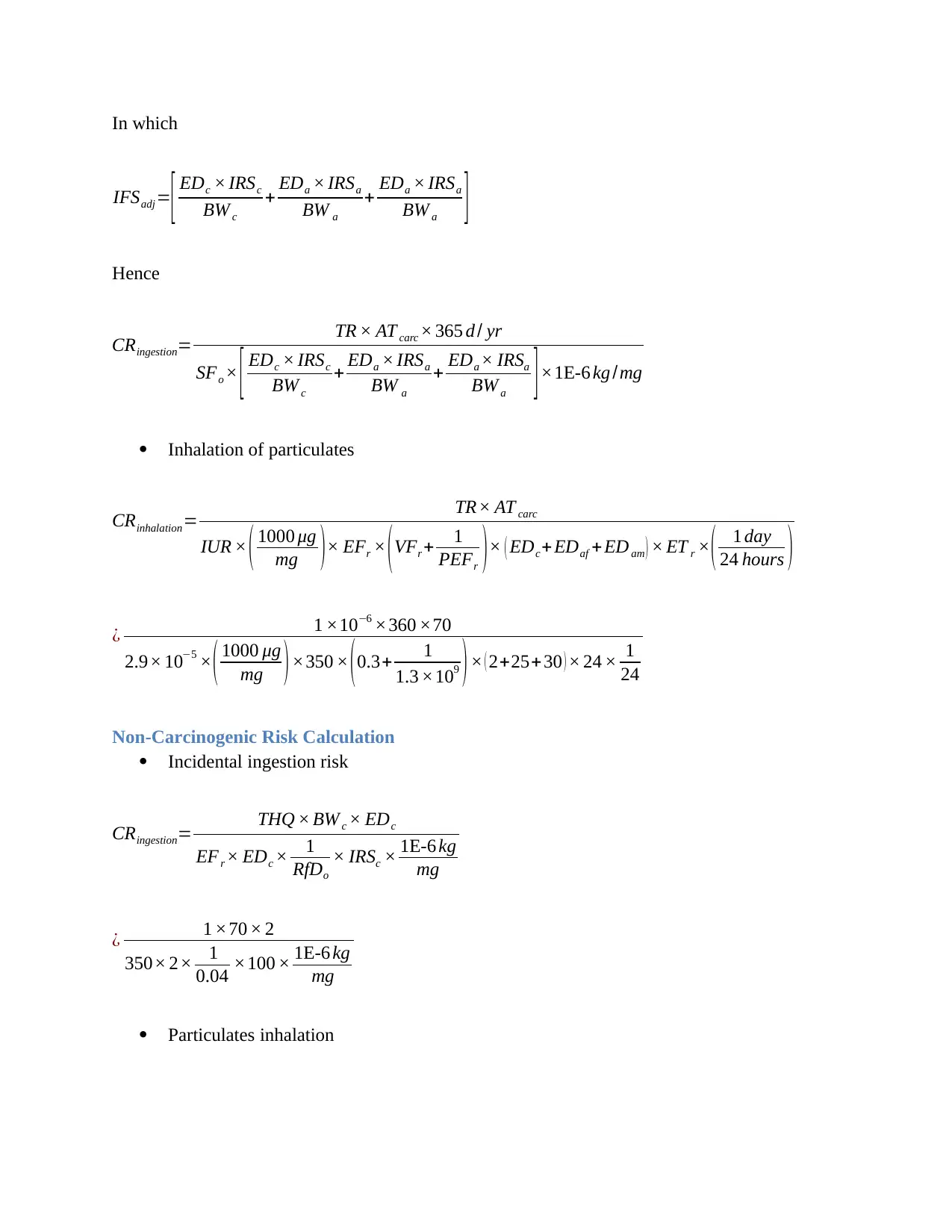
In which
IFSadj=
[ EDc × IRSc
BW c
+ EDa × IRSa
BW a
+ EDa × IRSa
BW a ]
Hence
CRingestion= TR × AT carc × 365 d / yr
SFo × [ EDc × IRSc
BW c
+ EDa × IRSa
BW a
+ EDa × IRSa
BW a ] ×1E-6 kg /mg
Inhalation of particulates
CRinhalation= TR× AT carc
IUR × ( 1000 μg
mg ) × EFr × ( VFr + 1
PEFr ) × ( EDc+ EDaf + ED am ) × ET r × ( 1 day
24 hours )
¿ 1 ×10−6 ×360 ×70
2.9× 10−5 × ( 1000 μg
mg )×350 × (0.3+ 1
1.3 ×109 )× ( 2+25+ 30 ) × 24 × 1
24
Non-Carcinogenic Risk Calculation
Incidental ingestion risk
CRingestion= THQ × BW c × EDc
EFr × EDc × 1
RfDo
× IRSc × 1E-6 kg
mg
¿ 1 ×70 × 2
350× 2× 1
0.04 ×100 × 1E-6 kg
mg
Particulates inhalation
IFSadj=
[ EDc × IRSc
BW c
+ EDa × IRSa
BW a
+ EDa × IRSa
BW a ]
Hence
CRingestion= TR × AT carc × 365 d / yr
SFo × [ EDc × IRSc
BW c
+ EDa × IRSa
BW a
+ EDa × IRSa
BW a ] ×1E-6 kg /mg
Inhalation of particulates
CRinhalation= TR× AT carc
IUR × ( 1000 μg
mg ) × EFr × ( VFr + 1
PEFr ) × ( EDc+ EDaf + ED am ) × ET r × ( 1 day
24 hours )
¿ 1 ×10−6 ×360 ×70
2.9× 10−5 × ( 1000 μg
mg )×350 × (0.3+ 1
1.3 ×109 )× ( 2+25+ 30 ) × 24 × 1
24
Non-Carcinogenic Risk Calculation
Incidental ingestion risk
CRingestion= THQ × BW c × EDc
EFr × EDc × 1
RfDo
× IRSc × 1E-6 kg
mg
¿ 1 ×70 × 2
350× 2× 1
0.04 ×100 × 1E-6 kg
mg
Particulates inhalation
⊘ This is a preview!⊘
Do you want full access?
Subscribe today to unlock all pages.

Trusted by 1+ million students worldwide
1 out of 22
Your All-in-One AI-Powered Toolkit for Academic Success.
+13062052269
info@desklib.com
Available 24*7 on WhatsApp / Email
![[object Object]](/_next/static/media/star-bottom.7253800d.svg)
Unlock your academic potential
Copyright © 2020–2025 A2Z Services. All Rights Reserved. Developed and managed by ZUCOL.